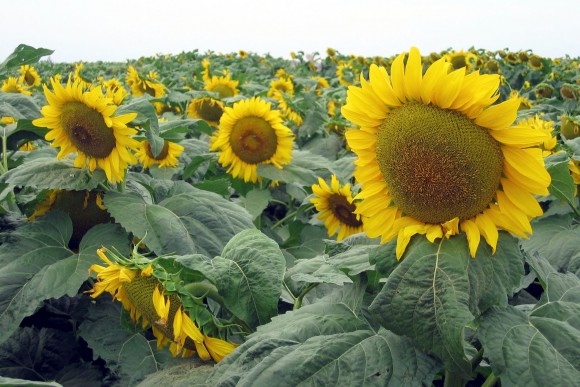A Depression-era program intended to save the nation’s farmers from ruin has grown into a 21st- century crutch enabling affluent growers and financial institutions to thrive at U.S. taxpayer expense.
Federal crop insurance encourages farmers to gamble on risky plantings in a program that has been marred by fraud and that illustrates why government spending is so difficult to control.
And the cost is increasing. The U.S. Department of Agriculture last year spent about $14 billion insuring farmers against the loss of crop or income, almost seven times more than in fiscal 2000, according to the Congressional Research Service.
The arrangement is a good deal for everyone but taxpayers. The government pays 18 approved insurance companies to run the program, pays farmers to buy coverage and pays the bills if losses exceed predetermined limits.
With a showdown over the nation’s finances — and a possible government shutdown — looming this fall, the growing insurance tab is a bipartisan target. President Barack Obama sought this year to cut almost $12 billion from the program over the next decade while his ideological opposite, Republican House Budget Committee Chairman Paul Ryan, has called subsidized insurance “crony capitalism.”
Lobbyists Win
Yet the president of the United States and Republicans’ chief budget expert are no match for the farm and insurance lobbies, which spent at least $52 million influencing lawmakers in the 2012 election cycle. Rather than thin the most expensive strand in the nation’s farm safety net, Congress is poised to funnel billions of dollars more to individuals who already are more prosperous than the typical American.
“We have been subsidizing some of the farmers who least need it in a way that is really costing taxpayers a lot of money,” said Senator Jeanne Shaheen, a Democrat of New Hampshire. “We’re never going to solve our budget challenges if that’s what we’re doing.”
Crop insurers and the USDA say that the subsidized insurance helps stabilize food prices for consumers while protecting farmers from weather-related losses. The program insured $117 billion worth of crops last year, including almost all the corn, soybeans, cotton and wheat grown in the U.S.
Capping Subsidies
Unlike direct farm aid payments, which are capped at $40,000 per farm, there is no limit on crop insurance subsidies. The names of those receiving payouts from the program are kept secret. There’s little chance the program will be restructured, since a permanent insurance mechanism spares politicians from approving ad-hoc farm bailouts that CRS says have cost taxpayers more than $50 billion since 2000.
The heavily-discounted insurance incentivizes farmers to cultivate marginal acres that may or may not be fertile. And the program’s been vulnerable to fraud, notably in North Carolina where a network of insurance agents, claims adjusters and farmers bilked the government of close to $100 million over more than a decade.

“The crop insurance program is terrible budget policy,” says William Frenzel, a 10-term Republican representative from Minnesota who served on the House Budget Committee and now analyzes fiscal issues at the Brookings Institution. “It’s the kind of congressional back-scratching that got us into our debt and deficit situation.”
Risk Factor
This is the first in a series of articles examining the U.S. crop insurance program, which advocates say is essential to the nation’s food supply and critics assail as wasteful corporate welfare. Other installments will examine how private insurance companies benefit from public assistance, the record North Carolina fraud and the program’s impact on the environment.
Crop insurance, intended to safeguard farmers from natural disasters, has mutated into an income support mechanism that almost eliminates risk from agriculture, say critics such as Vincent Smith, a professor of agricultural economics at Montana State University.
When last year’s drought drove corn prices to record highs, farmers with “harvest price option” policies were paid those inflated prices for what they didn’t grow — contributing to a record bill for taxpayers and record income for farmers. “There is no social justification for these subsidies,” says Smith. “This is a program that’s fundamentally designed to give money to farmers.”
Dustbowl Legacy
Federal crop insurance began in the shadow of the 1930s Dust Bowl, which scorched the soil and left farmers impoverished. Until 1980, when the government began paying about one-third of farmers’ premiums, few farmers participated.
In 2000, Congress made the subsidies more generous, so that farmers now pay only about 38 percent of their insurance bills or more than $4 billion in 2012. By last year, almost 1.2 million policies covering 282 million acres of farmland were in force.
Each year, farmers choose from a menu of insurance options — and by law, insurers are obligated to cover all who apply. More than seven in 10 policies guarantee income rather than yield.
The Washington-based Environmental Working Group, which supports more federal aid for conservation, says subsidies give farmers an incentive to buy “Cadillac” policies that over- insure their holdings and drive up costs. Some policies protect as much as 85 percent of a farm’s average yield.
Record Income
Taxpayers are helping farmers pay their bills even as farm income this year is expected to top $120 billion, its highest inflation-adjusted mark since 1973, according to the USDA’s Economic Research Service. Farm income has doubled over the past four years thanks to rising land values and surging exports.
In 2011, the median income of commercial farm households — those deriving more than half their income from farming — was $84,649, almost 70 percent higher than that of the typical American household.
Even as manufacturers and retailers struggle to rebound from the recession that ended four years ago, farm equity ended 2012 at $2.5 trillion, up 37 percent since the start of the recession in December 2007 — compared with a less than 1 percent gain in net worth for all U.S. households over the same period.
Citing “the record-breaking prosperity of American farmers,” Ryan, a Wisconsin Republican, said in March that “taxpayers should not finance payments for a business sector that is more than capable of thriving on its own.”
Policy Shift
The planned expansion of crop insurance reflects a decisive move in the nation’s farm policy away from direct payments to farmers.
The Congressional Budget Office says crop insurance will cost taxpayers about $90 billion over the next decade. If droughts like last year’s become more frequent, that could prove a conservative estimate: A February USDA report warned that even if greenhouse gases tied to climate change stabilize, “land surface temperatures will continue to rise for decades,” permanently altering planting zones.
Advocates say that with direct payments ending, crop insurance is all that stands between farmers and the unpredictable forces of nature. In the event of ruinous drought or disease, the program automatically disburses aid, often within 30 days, much faster than ad hoc bailouts, which can take more than a year.
Without government-subsidized insurance, financially- hobbled farmers might take land in and out of production, causing food prices to gyrate, according to Tom Zacharias, president of the National Crop Insurance Services, an industry group, who says the insurance costs about two cents per meal.
Farmers’ Tool
In an interview, Brandon Willis, administrator of the USDA’s Risk Management Agency, cited a University of Nebraska study that said crop insurance payments last year supported 20,900 jobs in four farm states. “More and more, crop insurance is the tool farmers rely on,” he said.
With new farm legislation stalled on Capitol Hill, largely over Republican demands for deeper cuts in food stamp spending, the cost of crop insurance is drawing fire from both ends of the political spectrum.
The Environmental Working Group says the insurance encourages farmers to make riskier plantings, secure in the knowledge they will be paid even if the crops fail. The free- market Club for Growth, meanwhile, derides the program as a government handout for millionaire farmers.
Wells Fargo, Ace
Even some beneficiaries are uneasy. “I like to think of myself as an independent who’s willing to take risk,” says farmer Jim Handsaker, 65, of Story City, Iowa. “With insurance, it takes the risk out of it.”
The USDA’s Risk Management Agency determines the policies’ costs and terms, while leaving marketing and claims payment to private companies. That means there’s no real price competition among the 18 approved insurers. The government doled out $1.4 billion last year to cover the administrative costs incurred by the companies, including a unit of Wells Fargo & Co, the nation’s fourth largest bank, Ace Ltd. of Switzerland, which reported a $2.7 billion profit last year, and privately-held Great American Insurance of Ohio.
Handsaker, a genial fan of the broadcaster Rush Limbaugh, farms about 3,400 acres of corn and soybeans with his brothers and sons. He says he paid about $70,000 to $80,000 in crop insurance premiums last year. The taxpayers paid even more — since an average of almost two-thirds of premium costs are paid by the government.
No Competition
“I have a lot of problems with the federal crop program,” Handsaker said as he sat in the kitchen of his one-story home, a Cadillac sedan parked outside. “It doesn’t matter who you purchase it from, it’s the same.”
Subsidized insurance also gives farmers an incentive to plant on land where crops may or may not flourish, he said, adding that he knew individuals in South Dakota who are “farming the program” with the intent of making an insurance claim rather than harvesting a crop.
The program’s formula for determining insurance premiums also “has created brittle farming operations that lack resilience and a spiral of ever-increasing taxpayer-subsidized” losses, according to an August report from the Natural Resources Defense Council, a Washington, D.C.-based environmental group.
Democratic Representative Ron Kind of Wisconsin expects that trend to worsen.
“You’re going to see a lot of unproductive land brought into production because the taxpayer will cover the losses from all these riskless decisions,” said Kind, whose proposal to limit program subsidies fell 10 votes short of passage in June. “My concern is that this is eliminating all risk.”
Big Subsidies
In 2011, the latest year for which data is available, 26 farmers each got annual subsidies of more than $1 million; more than 10,000 received $100,000 or more. One grower of tomatoes and peppers in Florida enjoyed a subsidy of $1.9 million, according to the Environmental Working Group. Congress has barred the USDA from revealing the identities of payout recipients.
In April, Obama’s fiscal year 2014 budget recommended slicing $11.7 billion from the program over the next decade by raising out-of-pocket costs for farmers and cutting administrative subsidies for insurers. Ryan, too, has called for trimming program spending.
Instead, the House-approved farm measure would expand crop insurance to guarantee as much as 90 percent of a farm’s income and extend coverage to peanut farms while the Senate bill covers farmers against even the modest losses they currently pay out of pocket.
Shaheen, the Democratic senator from New Hampshire, failed to persuade her colleagues to cap premium subsidies at $50,000, which she says could save $3.4 billion over 10 years.
Bullet-Proof
A glimpse at lobbying filings explains why the program is bullet-proof in Congress.
The 43 groups that wrote a joint letter to members of the Senate in March defending crop insurance collectively spent more than $52 million on lobbying during the 2012 election cycle, according to the Washington-based nonprofit Sunlight Foundation.
One signatory, the Independent Insurance Agents and Brokers of America, reported spending $1.6 million on lobbying last year and identified five registered lobbyists working on the program.
Individual companies including Ace, with $2.2 million, and Deere & Co., with $1.4 million, cited crop insurance in their lobbying reports.
Funding Lawmakers
Agribusiness employees also have been generous in funding political campaigns, contributing $91 million to candidates in the 2012 elections, up from $70 million four years earlier, according to the Center for Responsive Politics, a Washington- based research group.
In Nevada, Iowa, Mark Kenney, 33, raises corn, soybeans and oats on about 3,000 acres as yellow Union Pacific locomotives rumble west through the nearby fields. He defends crop insurance as the best response to the vicissitudes of farming.
“Would you rather pay a dime now or a dollar later?” Kenney asks. “Of all the industries to be involved in, the security of our food, fuel and fiber is of the greatest importance.”
Kenney, whose $150,000 premium represents roughly 10 percent of his total costs, says he doesn’t have much faith in alternative tools for managing risk, including financial contracts such as futures and options.
Premiums last year accounted for no more than 10 percent of corn growers’ average production costs of $349 per acre, said Bruce Babcock, an agricultural economist at Iowa State University. Farmers spent far more on seed, fertilizer, fuel and electricity.
Dropping Coverage?
If premium subsidies were reduced, many farmers would consider canceling their policies.
“If we had to pay what they say they subsidize, most of us wouldn’t have crop insurance because we couldn’t afford it,” says Mike Brown, 63, who along with his son Tanner farms 7,300 acres in Colby, Kansas. “Crop insurance is costing you $15 to $20 an acre. If they took all the subsidies out, it would be $50 to $60 an acre.”
Crop insurance funding will be determined when lawmakers reconcile competing House and Senate versions of the farm law. Congress faces a deadline of Sept. 30 to make a deal or extend a current stopgap funding measure.
Off the table: whether federally backed crop insurance should exist at all.
“We shouldn’t look at crop insurance as the least evil policy,” says Josh Sewell, senior policy analyst with Washington-based research group Taxpayers for Common Sense. “It’s not like our choice is to send checks one way or send checks another way. We could just not send checks.”
Editors: David Ellis, Jon Morgan
Topics USA Profit Loss Legislation Fraud Agribusiness North Carolina Washington Pollution
Was this article valuable?
Here are more articles you may enjoy.



 OpenAI Warns New Models Pose ‘High’ Cybersecurity Risk
OpenAI Warns New Models Pose ‘High’ Cybersecurity Risk  One of Highest Property Claims Severity Recorded in Q3 on Low Volume, Says Verisk
One of Highest Property Claims Severity Recorded in Q3 on Low Volume, Says Verisk  California Again Delays Wildfire Protection Rules for Homes
California Again Delays Wildfire Protection Rules for Homes  Brookfield Targets Global Dominance in P/C Insurance Coverage
Brookfield Targets Global Dominance in P/C Insurance Coverage 

